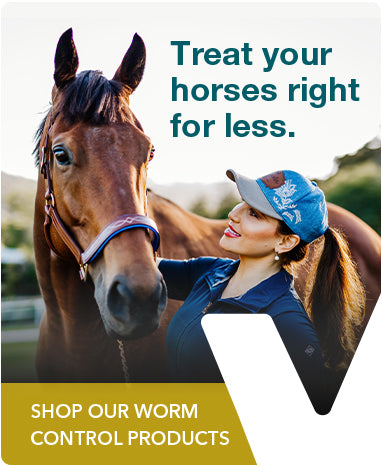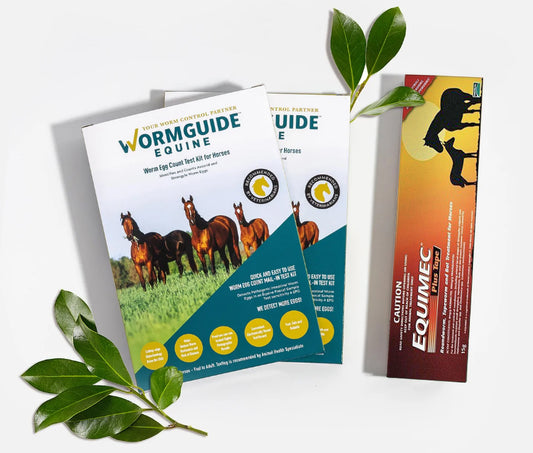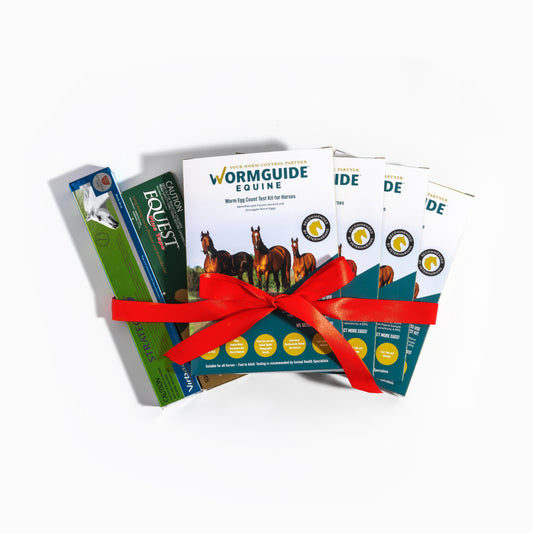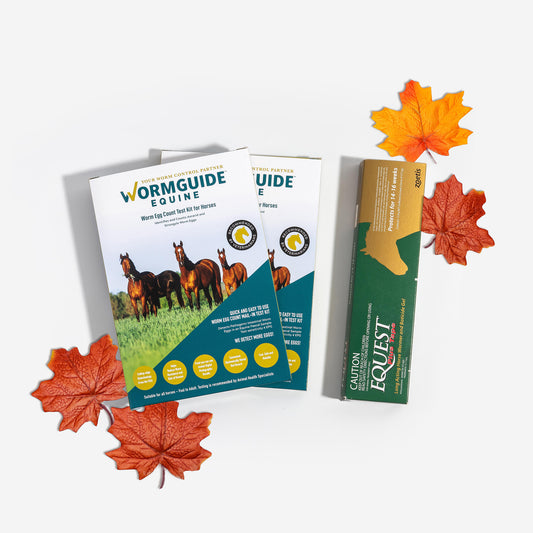Want to read an awesome article about how to help your horse overcome anxiety towards a worming syringe or oral medication? It`s easy peasy! And a fun way of training for both you and your horse.
It`s all about positive reinforcement and before you know it you have a happy, confident, and willing horse.
At WormGuide, we`ve been lucky enough to chat and meet many dedicated WormGuiders who shine the spotlight on horse welfare across many different contexts.
Here Julie shares her knowledge, insights, and expertise on science-based and ethically minded horse training.
Meet Julie Lannen

Julie Lannen is the owner and principal of the Australian Clicker Connection. Julie has an honours degree in psychology and a stage 2 certification from the Natural Animal Centre in the UK as an NAC Equine Behaviourist and is continuing with ongoing studies.
Clicker Training & it’s Usefulness for Worming
Sometimes training and management routines can cause stress for our horses. When management issues have been addressed, welfare can be enhanced through positive reinforcement. Positive reinforcement training has been shown to create positive reactions towards humans during training, increases contact and interest, improves cognitive abilities, is a conduit to enliven a positive memory of humans and enhances learning and memorisation of the training (Innes & McBride, 2007; Sankey et. al., 2010; Sankey et. al. 2010b).
Introduction to Clicker Training
Clicker training is the most common way to incorporate positive reinforcement into our horses training and management routines. It is used to teach behaviour using a "yes" signal to tell our horse that they did something we would like them to repeat. We usually use the noise from a clicker (a small plastic noisemaker) to bridge the gap between the desired behaviour and the delivery of the positive reinforcement (usually low GI treats). This increases the likelihood that the behaviour which was reinforced (clicked and treated) will be repeated. The clicker is very precise, and this gives us the opportunity of saying ‘yes’ to our horse as close as possible to when the behaviour occurred. The sound is short and instant and marks the desired behaviour allot quicker than words (and cannot be misunderstood). The concept is based on principles of classical conditioning which proposes that the best way to form an association between two stimuli is to 'mark' them within a short time of each other.
In most cases clicker training can help our horse recover from anxiety and use his/her curiosity to embrace what might have once been a fearful situation. We say here might have been a fearful situation, because there are some cases where our horse may be currently in fear. For these horses we need to help them over their fear first, and if this is your horse, it is best to begin with Constructional Approach Training before we begin clicker training. It is important to assess the level of fear responses first before we use clicker training. If this might be the case for your horse it is best first to check in with your equine behaviourist, or contact us. Let’s first look at a couple of examples from the literature, where horse’s welfare has increased with clicker training.
Innes & McBride (2008) compared training methods using schedules of either positive or negative reinforcement on ponies who had been subjected to chronic stress in the form of long-term neglect or cruelty. Over a 7-week period, 16 ponies were trained to lead in hand, stand to be groomed, traverse an obstacle course and load into a trailer using either positive (clicker training) or negative reinforcement (lightly touching the horse with a riding crop with increasing pressure until it responded with a near-correct response). It was found that during the latter stages of the training that ponies trained under a positive reinforcement schedule were more motivated to participate in the training sessions and exhibited more exploratory behaviours in novel situations and environments.
Hendriksen, et. al., (2011) compared the efficacy of clicker training verses pressure and release by training several horses who had a high fear response to load into a trailer. It was reported that all horses had previous bad experiences with trailer loading and could not be loaded past the beginning of the trailer ramp by their owners. The authors found that the level of discomfort and avoidance behaviours expressed during trailer loading was significantly greater in the group of horses who were in the negative reinforcement group (pressure and release) as compared to the group of horses who received positive reinforcement group (clicker training). Further, the overall training time with the positive reinforcement group was shorter than the time spent on a session in the negative reinforcement group.
How do we teach our horse clicker training?
It is a very simple process to begin with and one of the best ways is to click the clicker and give your horse a treat (this is called pairing). Within a short time, your horse will understand that as soon as he/she hears a click a treat is coming. Our horses LOVE treats, and sometimes during the initial pairing, they can become a little too aroused. So, it is best to begin with using a bucket to throw the treats into, and even use protected contact, because we have not yet taught our horse manners around treat delivery, and we don’t want our horse walking all over us. There are a few ways to do this, and we will now share ours – you can see the difference in arousal states. The following video is from our most recent clicker training DVD and shows a couple of examples as to how we began teaching the relationship between click and treat.
Clicker Training Basics Part 1
What if my Horse is in Fear?
As we mentioned earlier, we would not recommend clicker training if your horse were afraid ...…at first. There are many reasons for this, but an important one is that during clicker training the horse and human are very close to each other and when we begin to work on training with the clicker, we will be teaching behaviours and sometimes we will be teaching behaviours with the use of inanimate objects or asking our horse to approach something he or she is afraid of. Horses may be afraid because there is pain, there might be endocrine issues, or excess cortisol, there could be accidental trigger stacking (allostatic overload) or training that accidently involved punishment, to name a few. It is best to check in with someone who has a background in horse behavioural issues, before proceeding.
If we are confident that our horse has a fear only of an object or a person, and otherwise not demonstrating the negative impacts of fear, then we recommend using Constructional Approach Training to begin with. The easiest way to understand this approach is to think about what a horse does if he or she is afraid and can act out their natural behaviours. If given the opportunity our horse will run away – we call this taking distance. However, if a horse is restrained from acting out their natural behaviours, we may see the horse attack. Either situation is dangerous, and both demonstrate fear. There is a third behaviour, and this where a horse is overwhelmed with chronic stressors and is shut down. We would see a very stoic and non-reactive horse. This is called learned helplessness (and we would use other tools to help this horse first).
In Constructional Approach Training we take advantage of our horse’s ethological need for distance, to create confidence and mastery. We become the conduit to give distance to our horse, slowly working under the threshold. Here is a video from our most recent DVD where it explains the process. We recommend that if you think your horse might be currently afraid, to contact your equine behaviourist, or contact us and we can help you navigate Constructional Approach Training
Constructional Approach Training for Horses: The process explained.
Worming
Many of our horses have anxiety towards worming or oral medications. Sometimes fleeing, when they sense the wormer, is a reaction to what they know is coming up next but other times it is fear. We also have situations where the behaviour is a learned behaviour – where our horse has worked out just what they need to do to make sure we cannot worm them (or squirt other things in their mouth). The idea here is that if they fuss ‘loudly’ we cannot squeeze that tube or syringe, we stop, or loose it all over us. Our horse’s behaviour is being negatively reinforced by us in this way. Many owners’ resort to worming pellets because of these situations. But this is not a good idea because we cannot provide a targeted response to seasonal worms, and if we must give oral medication for a medical issue, we risk a rise in cortisol, at a time when our horse’s resilience is low. To test what our horse is experiencing, it is often a good idea to start with Constructional Approach Training. If this is the case, contact us and we can assist.
In the following example we will show you how Evie was helped with clicker training. She was assessed before she began and she showed no signs of fear, but rather she had an aversion to anything that was going to be put near her mouth, after one bad worming incident (classical conditioning is a very powerful tool). Evie participated in a taste test of various liquids to see what was the one she preferred the most. We then changed out the wormer tube for a clear syringe. Initially we begin with pellets or chaff as treats as a reward for the changing responses with the syringe near the mouth. Once we at the stage where she was happy to accept the syringe near her mouth, we used a liquid as a treat. In the first two clips there is allot of wind noise, so you might want to lower the sound. The process was very successful, but unfortunately the lens of the video of the first real worming was not pointing at the action, so we only have memories!
Evie and mock worm - before.
Video kindly provided by Sarah Blackburn of Blackburn Equitation
Clicker to reinforce any behaviour using successive approximations (shaping).
Video kindly provided by Sarah Blackburn of Blackburn Equitation
Using the syringe to give the treat.
Video kindly provided by Sarah Blackburn of Blackburn Equitation
Finally, we will show one more example. The mare you are about to see needed ulcer medication. She was accepting of the medication the first couple of days but became progressively more reluctant - so knowing it had to be done every day for a month, the same process was used to make the experience more pleasant for horse and human. This is a very compressed video, but it is watchable - here is the first try with the meds:
Giving ulcer medication.
Video kindly provided by Sarah Blackburn of Blackburn Equitation










